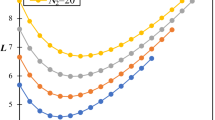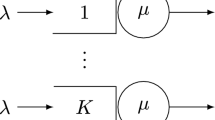Abstract
We study an enhanced hysteretic control system, with primary and secondary queues and random batch service. When the primary queue down-crosses r, the server operates on two parallel lines, servicing them asynchronously until the primary line of remaining units is processed or the number of serviced secondary units is at least S, whichever comes first. The server then waits until the primary queue length reaches N (if needed) before returning to primary service. The server capacity of primary units is limited by R with two options: r ≤ R ≤ N and R > N. Using fluctuation analysis we obtain closed-form distributions of available units during key periods of time and the steady state distribution of the primary queue. We illustrate analytical tractability by numerous analytical and computational examples.
Similar content being viewed by others
References
Abaev P, Razumchik R (2013) Queuing model for SIP server hysteretic overload control with bursty traffic. In: Balandin S, Andreev S, Koucheryavy Y (eds) Internet of Things, Smart spaces, and next generation networking, volume 8121 of lecture notes in computer science. ruSMART 2013, NEW2AN. Springer, Berlin, p 2013
Abaev P, Gaidamaka Y, Samouylov K (2014) Hysteretic control technique for overload problem solution in network of sip servers. Comput Inf 33:218–236
Abolnikov L, Dukhovny A (1991) Markov chains with transition delta-matrix: ergodicity conditions, invariant probability measures and applications. J Appl Math Stoch Anal 4(4):335–355
Abolnikov L, Agarwal RV, Dshalalow J (2008a) Random walk analysis of parallel queueing stations. Math Comput Model 47:452–468
Abolnikov L, Dshalalow J, Treerattrakoon A (2008b) On dual hybrid queueing systems. Nonlinear Anal Hybrid Syst 2(1):96–109
Ait-Salaht F, Castel-Taleb H (2015) The threshold based queueing system with hysteresis for performance analysis of clouds. In: IEEE transactions on computers, 2015 international conference on computer, information and telecommunication systems (CITS), pp 1–5
Avrachenkov K, Perel E, Yachiali U (2016) Finite-buffer polling systems with threshold-based switching policy. TOP 24:541–571
Bekker R (2009) Queues with Lévy input and hysteretic control. Queueing Syst 63:281–299
Bingham NH (2001) Random walk and fluctuation theory. In: Shanbhag DN, Rao CR (eds) Handbook of statistics, vol 19, chapter Random walk and fluctuation theory. Elsevier Science, pp 171–213
Boxma O, Löpker A, Perry A (2016) On a make-to-stock production/mountain model with hysteretic control. Ann Oper Res 241(1-2):53–82
Cao J, Xie W (2017) Stability of two-queue cyclic polling system with BMAPs under gated service and state-dependent time-limited service disciplines. Queueing Syst 85:117–147
Chan CW, Armony M, Bambos N (2016) Maximum weight matching with hysteresis in overloaded queues with setups. Queueing Syst 82:315–351
Choi SH, Sohrabi K (2000) Analysis of a mobile cellular systems with hand-off priority and hysteresis control. In: Nineteenth annual joint conference of the IEEE computer and communications societies. Proceedings, INFOCOM 2000. IEEE
Dikong EE, Dshalalow J (1999) Bulk input queues with hysteretic control. Queueing Syst 32:287–304
Dshalalow J (1994) On termination time processes. In: Galambos J, Gani J (eds) Studies in applied probability: essays in honour of Lajos Takács. Applied Probability Trust, Sheffield, pp 325–336
Dshalalow J (1995) Excess level processes in queueing. In: Dshalalow JH (ed) Advances in queueing. CRC Press, Boca Raton, pp 243–262
Dshalalow J (1997a) On the level crossing of multi-dimensional delayed renewal processes. J Appl Math Stoch Anal 10(4):355–361
Dshalalow J (1997b) Queueing systems with state dependent parameters. In: Dshalalow JH (ed) Frontiers in queueing. CRC Press, Boca Raton, pp 61–116
Dshalalow J (1998) Queues with hysteretic control by vacation and post-vacation periods. Queueing Syst 29:231–268
Dshalalow J (2012) Lecture notes on stochastic processes. Florida Institute of Technology, Melbourne
Dshalalow J, Dikong EE (1999) On generalized hysteretic control queues with modulated input and state dependent service. Stoch Anal Appl 17(6):937–961
Dshalalow J, Merie A (2018) Fluctuaton analysis in queues with several opereational modes and priority customers. TOP. https://doi.org/10.1007/s11750-018-0478-3
Dshalalow J, Kim S, Tadj L (2006) Hybrid queueing systems with hysteretic bilevel control policies. Nonlinear Anal 65(11):2153–2168
Dudin A, Chakravarthy S (2002) Optimal hysteretic control for the BMAP/G/1 system with single and group service modes. Ann Oper Res 112:153–169
Dudin A, Nishimura S (2000) Optimal hysteretic control for a BMAP/SM/1/N queue with two operation modes. Math Probl Eng 5:397–419
Dukhovny A (1994) Multiple roots of some equations in queueing theory. Stoch Model 10(2):519–524
Gaidamaka Y, Pechinkin A, Razumchik R, Samouylov K, Sopin K (2014) Analysis of an M/G/1/R queue with batch arrivals and two hysteretic overload control policies. Int J Appl Math Comput Sci 24(3):519–534
Golubchik L, Lui JCS (2002) Bounding of performance measures for a threshold-based queueing system with hysteresis. IEEE Trans Comput 51(4):353–372
Jain M, Sharma R, Sharma GC (2013) Multiple vacation policy for MX/Hk/1. J Ind Eng Int 9(36):1–11
Ke J-C (2006) An M/G/1 queue under hysteretic vacation policy with an early startup and un-reliable server. Math Meth Oper Res 63:357–369
Kim C, Dudin AN, Dudin S, Dudina O (2016) Hysteresis control by the number of active servers in queueing system with priority service. Perform Eval 101:20–33
Loris-Tegham J (1978) Hysteretic control of an M/G/1 queueing system with two service time distributions and removable server. In: Point processes and queueing problems, volume 24 of 291–305. Colloquia Mathematics Societatis Janos Bolyai, Hungary
Pechinkin A, Razumchik R (2013) Stationary characteristics of M2/G/1/r system with hysteretic policy for arrival rate control. J Commun Technol Electron 58 (12):1282–1291
Semenova OV (2017) Optimal hysteresis control for BMAP/SM/1 queue with MAP-input of disasters. Qual Technol Quant Manag 4(3):395–405
Sikdar K, Gupta UC (2008) On the batch arrival batch service queue with finite buffer under server’s vacation: MX/GY/1/n queue. Comput Math Appl 56(11):2861–2873
Tadj L, Ke J-C (2005) Control policy of a hysteretic bulk queueing system. Math Comput Model 41(4–5):571–579
Takács L (1976) On fluctuation problems in the theory of queues. Adv Appl Probab 8(3):548–583
Takagi H (2000) Performance evaluation: origins and directions, chapter analysis and application of polling models. In: Harling G, Lindemann C (eds). Springer, Berlin
Tegham J (1986) Control of the service process in a queueing system. Eur J Oper Res 23(2):141–158
Tian N, Zhang ZG (2006) Vacation queueing models. Springer, New York
Van der Gaast JP, Adan IJBF, de Koster RBM (2017) The analysis of batch sojourn-times in polling systems. Queueing Syst 85:313–335
Vishnevskii VM, Dudin AN (2017) Queueing systems with correlated arrival flows and their applications to modeling telecommunication networks. Autom Remote Control 78(8):1361–1403
Wu W, Tang Y, Yu M (2014) Analysis of an M/G/1 queue with multiple vacations, N-policy, unreliable service station and repair facility failures. Int J Supply Oper Manag 1(1):1–19
Zhennovyi YV, Zhennovyi KY (2014) Stationary characteristics of an \(\text {M}_{2}^{X}\)/M/n queue with hysteretic control of the input flow intensity. J Commun Technol Electron 59(6):614–621
Acknowledgements
The authors are indebted to the anonymous referee for valuable suggestions and remarks that helped improve the paper.
Author information
Authors and Affiliations
Corresponding author
Additional information
Publisher’s Note
Springer Nature remains neutral with regard to jurisdictional claims in published maps and institutional affiliations.
Rights and permissions
About this article
Cite this article
Dshalalow, J.H., Merie, A. & White, R.T. Fluctuation Analysis in Parallel Queues with Hysteretic Control. Methodol Comput Appl Probab 22, 295–327 (2020). https://doi.org/10.1007/s11009-019-09701-z
Received:
Revised:
Accepted:
Published:
Issue Date:
DOI: https://doi.org/10.1007/s11009-019-09701-z




